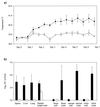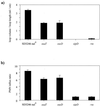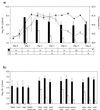Salmonella pathogenicity island 2 influences both systemic salmonellosis and Salmonella-induced enteritis in calves
- PMID: 11119526
- PMCID: PMC97892
- DOI: 10.1128/IAI.69.1.367-377.2001
Salmonella pathogenicity island 2 influences both systemic salmonellosis and Salmonella-induced enteritis in calves
Abstract
We have used signature-tagged mutagenesis to identify mutants of the host-specific Salmonella enterica serotype Dublin which were avirulent in calves and/or BALB/c mice. A mutant with a transposon insertion in the sseD gene of Salmonella pathogenicity island 2 (SPI-2), which encodes a putative secreted effector protein, was identified. This mutant was recovered from the bovine host but not from the murine host following infection with a pool of serotype Dublin mutants. However, a pure inoculum of the sseD mutant was subsequently shown to be attenuated in calves following infection either by the intravenous route or by the oral route. The sseD mutant was fully invasive for bovine intestinal mucosa but was subsequently unable to proliferate to the same numbers as the parental strain in vivo. Both the sseD mutant and a second SPI-2 mutant, with a transposon insertion in the ssaT gene, induced significantly weaker secretory and inflammatory responses in bovine ligated ileal loops than did the parental strain. These results demonstrate that SPI-2 is required by serotype Dublin for the induction of both systemic and enteric salmonellosis in calves.
Figures







References
-
- Ahmer B M M, van Reeuwijk J, Watson P R, Wallis T S, Heffron F. Salmonella SirA is a global regulator of genes mediating enteropathogenesis. Mol Microbiol. 1999;31:971–982. - PubMed
-
- Beuzon C R, Banks G, Deiwick J, Hensel M, Holden D W. pH-dependent secretion of SseB, a product of the SPI-2 type III secretion system of Salmonella typhimurium. Mol Microbiol. 1999;33:806–816. - PubMed
-
- Bulgin M S. Salmonella dublin: what veterinarians should know. J Am Vet Med Assoc. 1983;182:116–118. - PubMed
Publication types
MeSH terms
LinkOut - more resources
Full Text Sources
Research Materials
Miscellaneous

